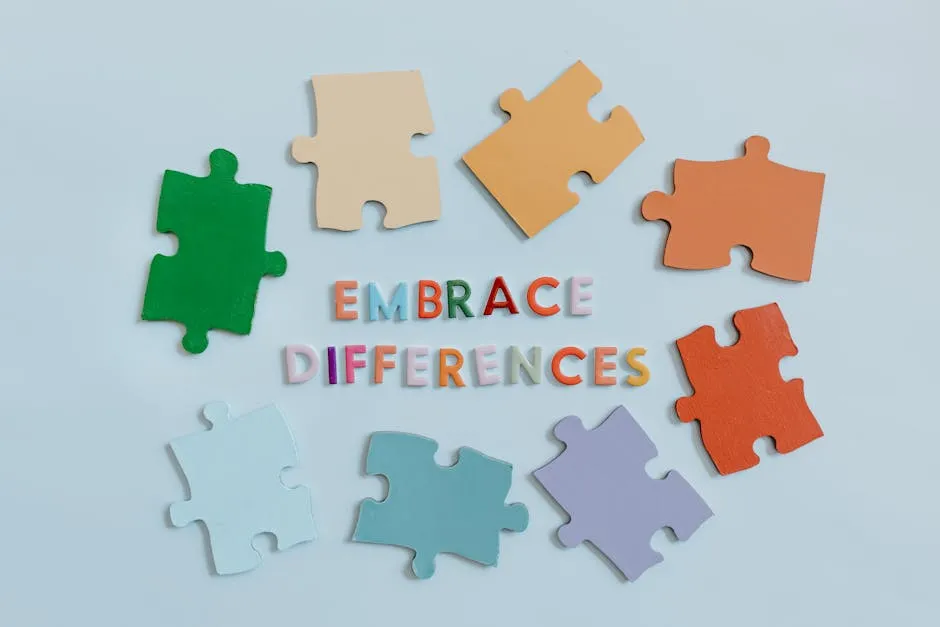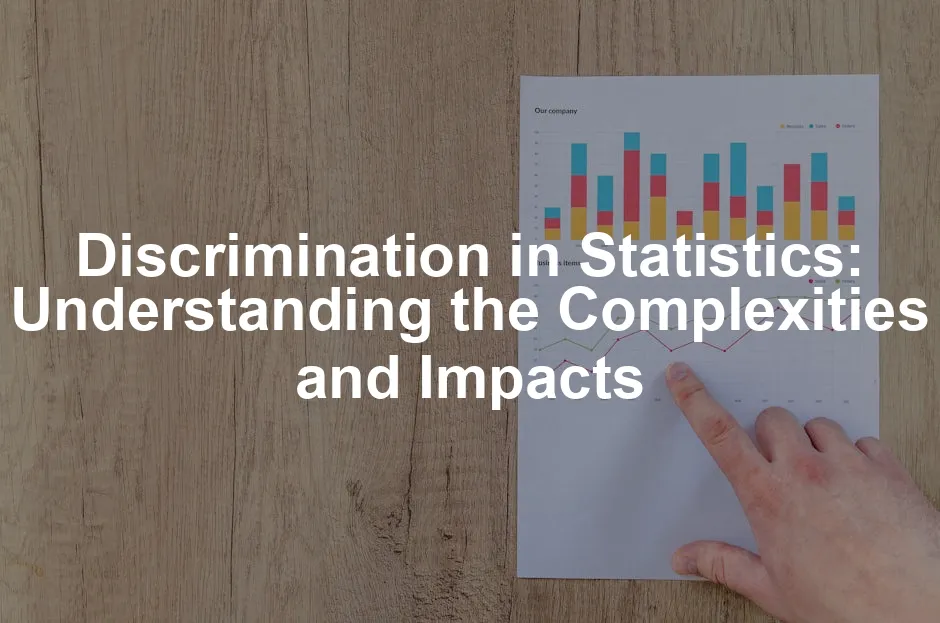Introduction
Discrimination in statistics takes on many forms, but one of the most intriguing is statistical discrimination. This theoretical framework asserts that economic agents—like employers or consumers—often rely on group averages when making decisions. Rather than assessing individuals based on their unique traits, they fall back on generalized beliefs. Think of it as using a lazy shortcut that can lead to significant disparities in how people are treated.
In today’s society, the relevance of statistical discrimination is more pronounced than ever. It’s not just a dry, academic concept; it ripples through our economic systems, labor markets, and social justice movements. For instance, employers may assume that women are less productive based solely on historical data rather than individual performance. These assumptions can lead to wage gaps and missed opportunities, perpetuating cycles of inequality.
The objective of this article is to peel back the layers of statistical discrimination. We’ll examine its causes, effects, and potential solutions. By dissecting this concept, we aim to foster a deeper understanding of how statistical discrimination operates and the real-world implications it carries.
Speaking of deeper understanding, if you’re looking for a profound literary exploration of race and identity, check out “Invisible Man” by Ralph Ellison. This classic novel dives deep into the complexities of race and identity in America, making it a fantastic read while you ponder the nuances of statistical discrimination.
Throughout this exploration, readers will learn how statistical discrimination differs from taste-based discrimination, which is rooted in prejudice. We’ll also uncover the mechanisms that drive these biases, the types of statistical discrimination that exist, and the strategies for combating them. This knowledge is not just academic; it’s essential for fostering a more equitable society where individuals are evaluated on their merits rather than their group affiliations.

Understanding Statistical Discrimination
Definition and Origins
Statistical discrimination refers to the practice of making decisions based on group characteristics rather than individual merit. It’s a concept firmly grounded in economic theory. The roots trace back to influential economists like Kenneth Arrow and Edmund Phelps, who laid the groundwork for understanding how group averages can inadvertently lead to unfair treatment.
Arrow’s work in the 1970s highlighted how employers, faced with imperfect information about individual productivity, might rely on stereotypes linked to demographic groups. Similarly, Phelps’s research emphasized that this behavior could perpetuate existing inequalities. The essence of statistical discrimination is that it can arise even among rational decision-makers who are not overtly biased but rely on flawed assumptions about group performance.
Understanding this concept is vital. It contrasts sharply with taste-based discrimination, where decisions are influenced by personal prejudices. In taste-based discrimination, a hiring manager might choose a less qualified candidate due explicitly to their racial or gender bias. Statistical discrimination, however, operates on the premise that individuals within marginalized groups are inherently less capable based on historical or aggregate data, regardless of their actual abilities.
The distinction matters. Recognizing the difference can help us address the root causes of discrimination. It allows for a more nuanced approach to policy-making, which can lead to better-targeted interventions.
As we unravel the complexities of statistical discrimination, it becomes clear that its implications are profound. From hiring practices to lending policies, the way we interpret data can have life-altering consequences for individuals. Understanding these dynamics is the first step toward creating a fairer, more just society.

Mechanisms of Statistical Discrimination
Group Characteristics and Decision-Making
Decision-makers often lean on group averages to make judgments. This means they might evaluate individuals based on the perceived traits of their demographic group. For instance, a hiring manager could assume that women are less productive simply because studies show that, on average, women earn less than men. It’s a classic case of generalizing the group to the individual, which can seriously skew judgment.
Imagine a tech company hiring software engineers. If the hiring team believes that male candidates are better coders based on historical data, they might overlook a highly qualified female candidate. This practice often leads to missed opportunities for talented individuals who don’t fit the stereotype.
Another example? Think about insurance companies. They might charge higher premiums to individuals in certain demographic groups, assuming they pose a greater risk. This practice can stem from historical claims data, which is often skewed by societal and economic factors. The individual may have a spotless record, but they bear the brunt of their group’s average risk. Such decision-making can lead to significant economic disparities and reinforce existing biases.

To help you stay hydrated during all this reading, consider grabbing a Hydro Flask Water Bottle. It keeps your drinks cold for hours, so you can sip while you ponder the complexities of statistical discrimination!
The Role of Imperfect Information
Imperfect information fuels reliance on group statistics. When decision-makers lack complete knowledge about individuals, they often turn to the easiest available data: group averages. This approach can perpetuate cycles of disadvantage for marginalized groups. For instance, if employers believe that all minority candidates are less skilled based on aggregate data, they may overlook skilled applicants from those groups.
Consider the job market again. A manager might assume that candidates from historically marginalized backgrounds are less qualified due to a lack of representation in higher-level positions. This belief can discourage talented individuals from applying, leading to a self-fulfilling prophecy. Over time, these misconceptions create barriers that hinder economic mobility for entire communities.
Moreover, this reliance can become a vicious cycle. If individuals from disadvantaged groups see fewer opportunities, they might invest less in education or skill development. As a result, the group’s average performance may drop, further reinforcing the stereotypes that led to their initial disadvantage. It’s a daunting loop that continues to spiral unless conscious efforts are made to break it.
Statistical discrimination is not just a theoretical concept; it has real-world implications. Understanding how group characteristics and imperfect information influence decision-making can help us devise strategies to combat bias. It’s crucial to recognize that each individual possesses unique talents, regardless of the group they belong to. By shifting our focus from group averages to individual merits, we can pave the way for a fairer and more equitable society.

Types of Statistical Discrimination
First Moment vs. Second Moment Discrimination
Statistical discrimination can be classified into two main types: first moment and second moment discrimination. First moment discrimination occurs when decisions are based on average group characteristics. For example, if an employer assumes that female workers are less productive than male workers, they may offer lower wages to women regardless of individual performance. This type of discrimination is often rooted in historical wage disparities and societal perceptions.
A real-world example? Consider the tech industry again. If a company believes that men are more likely to succeed in tech roles, they might be less inclined to promote women to leadership positions, even if their contributions are equal. This leads to wage disparities and reinforces gender stereotypes.
On the other hand, second moment discrimination revolves around the variance in group performance. Here, decision-makers might assume that one group’s performance is more predictable than another’s. For instance, a risk-averse employer may prefer to hire from a group with lower variance in productivity, even if the average productivity is the same across groups.
Imagine two candidates, both with excellent track records. If one candidate is from a group with historically consistent performance, while the other belongs to a group with more variability, the employer might choose the former. This can occur even if both candidates possess identical qualifications. The reliance on perceived risk can lead to unequal treatment in hiring and wage offers.
Both types of statistical discrimination highlight the pitfalls of relying on group data over individual assessments. They reinforce stereotypes and contribute to systemic inequalities. Recognizing these distinctions is crucial to understanding how statistical discrimination operates in various economic contexts. By tackling both first moment and second moment discrimination, we can work towards creating a more equitable labor market for all.

Case Studies and Empirical Evidence
Statistical discrimination isn’t just a theoretical concept; it plays out in real-world scenarios across various sectors. Let’s take a look at some case studies that highlight its impact.
In labor markets, research shows a persistent wage gap between men and women. A 2004 study by David L. Dickenson and Ronald L. Oaxaca examined statistical discrimination in hiring practices. They found that employers often offered lower wages to female candidates, assuming they were less productive. This assumption stems from historical wage disparities rather than actual performance data. The study emphasizes that even when women and men possess similar qualifications, women frequently face pay discrimination based solely on group averages. For more insights into education statistics, you can refer to the education statistics digest.
Understanding the wage gaps and their implications is crucial. education statistics digest provides further insights into the trends and resources related to this issue.
Moving to the insurance sector, statistical discrimination rears its head again. Insurance companies often base premium rates on group characteristics. For instance, a study highlighted that African American individuals might face higher car insurance rates due to their demographic group’s historical data on claims. Even if a particular driver has a clean record, they may still be penalized because of assumptions made about their group’s average risk level. This practice underscores how group statistics can lead to unfair pricing and access issues.
In lending, statistical discrimination can be particularly damaging. A study published in the American Economic Review revealed that minority borrowers often receive less favorable loan terms. Lenders, acting on perceived risk associated with specific demographics, may impose higher interest rates or deny loans altogether. This behavior reinforces existing inequalities and makes it difficult for marginalized groups to achieve financial stability.
Empirical research has shown that these patterns of statistical discrimination can create self-reinforcing cycles. Kenneth Arrow’s foundational work on the subject points to how stereotypes about minority productivity can persist even among rational decision-makers. When employers rely on group statistics, they often overlook qualified individuals, creating a vicious circle that limits opportunities for entire groups.

Impacts of Statistical Discrimination
Economic Consequences
Statistical discrimination has significant economic implications, particularly in the labor market. The reliance on group averages contributes to persistent wage gaps and employment disparities. For example, women often earn less than men, primarily due to assumptions about their productivity. These wage gaps are not merely anecdotal; they impact economic mobility and stability for entire families.
Moreover, marginalized groups face barriers in accessing well-paying jobs. Employers may overlook qualified candidates from these groups due to preconceived notions about their capabilities. This not only limits individual potential but also hinders overall economic growth. When talented individuals are excluded from high-skill jobs, society loses out on valuable contributions.
The long-term economic consequences are profound. Over time, persistent wage disparities can lead to wealth accumulation differences between groups. Lower wages often translate into less savings and investment in education, perpetuating cycles of poverty. For marginalized communities, this systemic disadvantage translates into reduced economic mobility and a widening wealth gap.

To make your cooking more efficient while pondering these implications, consider investing in an Instant Pot Duo 7-in-1 Electric Pressure Cooker. It’s a lifesaver for busy days and keeps you nourished while you dive deep into these critical discussions!
Social and Psychological Effects
The psychological impact of statistical discrimination can be just as debilitating. Individuals subjected to this kind of bias often experience reduced self-esteem and motivation. Constantly being judged by group averages can lead to feelings of inadequacy. For instance, women in male-dominated fields may doubt their abilities due to the prevailing stereotype that men are better suited for these roles.
Moreover, the broader societal implications are concerning. Statistical discrimination reinforces harmful stereotypes and deepens social divides. When individuals are judged based on their demographic group, it perpetuates a narrative that certain groups are inherently less capable. This not only impacts individuals but also shapes societal perceptions, leading to increased tensions and a lack of cohesion.
Additionally, the cycle of discrimination can stifle diversity and innovation. A lack of varied perspectives in workplaces can result in a homogenous environment where creativity suffers. Diverse teams, however, have been shown to drive better performance and foster innovation. By failing to recognize individual talents, organizations miss out on the benefits that diversity brings to the table.
Ultimately, addressing the impacts of statistical discrimination requires a multifaceted approach. By challenging stereotypes and promoting individual assessment, we can pave the way for a more equitable society. It’s essential to recognize that every person has unique strengths, and embracing this individuality can dismantle the barriers created by statistical discrimination.

Addressing Statistical Discrimination
Policy Interventions
Statistical discrimination is a stubborn beast. It thrives on stereotypes and generalizations, often leading to unfair treatment in various sectors. Tackling this issue requires robust policy interventions. Measures like affirmative action and anti-discrimination laws come to mind. These strategies aim to level the playing field and dismantle the biases that underpin statistical discrimination.
Affirmative action policies are designed to promote equal opportunities for underrepresented groups. They encourage organizations to consider demographic diversity in hiring and education. By actively seeking to include individuals from marginalized backgrounds, these policies aim to counteract the historical disadvantages faced by these groups. Research shows that affirmative action can lead to more diverse workplaces, which in turn fosters innovation and creativity. A study by the American Economic Review found that companies implementing such policies witnessed improved performance, suggesting that diversity isn’t just a moral imperative but also a smart business strategy.
On the flip side, we must look at anti-discrimination laws. These laws prohibit unfair treatment based on race, gender, or other characteristics in employment and housing. By creating legal repercussions for discriminatory practices, these laws serve as a deterrent. However, their effectiveness can be a mixed bag. A 2020 study revealed that while these laws help raise awareness, they sometimes do little to change underlying biases. In some cases, they may even lead to “backlash,” where decision-makers subconsciously double down on their biases due to perceived threats to their status.
To truly understand the effectiveness of these measures, we must analyze specific case studies. For example, consider the impact of affirmative action on college admissions. Institutions that adopt these policies have seen an increase in minority enrollment. However, the effectiveness varies based on implementation and societal attitudes. In a recent investigation, researchers noted that while affirmative action improved access for some groups, it also sparked intense debates about meritocracy and fairness, highlighting the complexity of navigating these waters.
In conclusion, while policy interventions hold promise, they also face challenges. To reduce statistical discrimination effectively, we must continually assess and refine these policies. Organizations need to be transparent about their diversity goals and strive for genuine inclusivity. After all, a policy is only as good as its execution.

Promoting Awareness and Education
Education is a powerful tool in the fight against statistical discrimination. By promoting awareness, we can help decision-makers recognize their biases and the consequences of relying on group averages. Understanding the nuances of statistical discrimination is crucial for fostering a more equitable environment.
Organizations can implement training programs that highlight the impact of biases in decision-making. Workshops can educate employees about statistical discrimination and its real-world implications. By illustrating how these biases manifest, organizations can empower their teams to make more informed choices. For instance, a study from Harvard Business School found that companies that engaged in bias training significantly reduced discriminatory hiring practices.
Another strategy involves integrating diversity and inclusion initiatives into organizational culture. When leaders prioritize these values, it sends a clear message throughout the organization. Creating an environment where diverse voices are heard and valued is essential for combating statistical discrimination. This can be achieved through mentorship programs, employee resource groups, and inclusive hiring practices.
Furthermore, organizations should leverage data to track progress. By collecting and analyzing demographic data, they can identify patterns of discrimination within their hiring practices. This transparency not only holds organizations accountable but also fosters a culture of continuous improvement. Companies that openly share their diversity metrics often see a boost in employee morale and public perception.
Incorporating real-life examples can also drive home the message. Sharing success stories of individuals who overcame statistical discrimination can inspire others. Highlighting the achievements of underrepresented groups can shift perceptions and challenge stereotypes.
Ultimately, education and awareness are critical components in addressing statistical discrimination. By equipping individuals with the knowledge to recognize and challenge biases, we can create a more equitable landscape where everyone has the opportunity to thrive.

FAQs
What is the difference between statistical discrimination and taste-based discrimination?
Statistical discrimination relies on group averages to make decisions. It’s like judging a book by its cover, assuming everyone in a group shares the same traits. For example, a hiring manager might think women are less productive based on historical data, even if individual candidates are highly qualified. This form of discrimination isn’t born from hatred but from flawed reasoning. On the other hand, taste-based discrimination stems from personal prejudices. Imagine a hiring manager who refuses to hire a qualified Black candidate simply because of their race. This reflects deep-seated bias, not just statistical assumptions. Understanding this distinction is essential for addressing the root causes of discrimination effectively.
How can statistical discrimination be reduced in the workplace?
Organizations can take several practical steps to combat statistical discrimination. First, they should implement blind recruitment processes. This means removing names and demographic information from resumes to focus solely on skills and experience. Second, training programs on unconscious bias can help employees recognize their assumptions. Workshops can foster discussions about the importance of evaluating individuals based on their merits rather than stereotypes. Lastly, organizations should set diversity goals and monitor progress. Regularly reviewing hiring and promotion data can highlight disparities, encouraging accountability and continuous improvement. By focusing on these strategies, companies can create a more inclusive environment.
What are the long-term effects of statistical discrimination on marginalized communities?
Statistical discrimination can have dire long-term effects on marginalized communities. Economically, it perpetuates wage gaps and limits access to better job opportunities. When employers assume lower productivity based on group averages, they deny qualified individuals the chance to excel. This results in reduced economic mobility and a cycle of poverty. Socially, the implications can be equally damaging. When entire groups are viewed through the lens of stereotypes, self-esteem can plummet. The constant pressure to defy negative expectations can lead to disengagement from the workforce and society. This erodes social cohesion and fuels division, making it harder for communities to unite and thrive.
Are there any successful case studies of interventions against statistical discrimination?
Yes, there are several successful interventions. One notable example is the use of “blind” hiring practices in tech companies. These firms have reported increased diversity in their candidate pools and improved hiring outcomes after removing identifying information from applications. Another successful case is the implementation of training programs that focus on unconscious bias, which has shown to reduce discriminatory practices in hiring. A study by Harvard Business School found that companies with such programs saw a significant decrease in bias-related hiring decisions, leading to a more diverse workforce. These case studies demonstrate that targeted interventions can effectively combat statistical discrimination, paving the way for a more equitable workplace.
Please let us know what you think about our content by leaving a comment down below!
Thank you for reading till here 🙂
All images from Pexels




